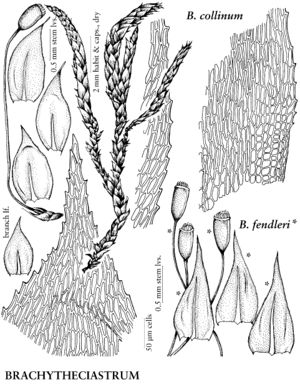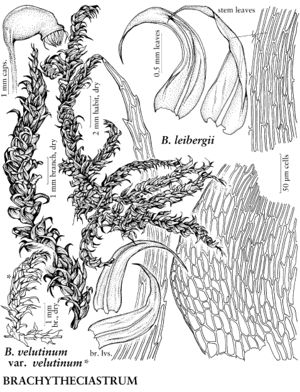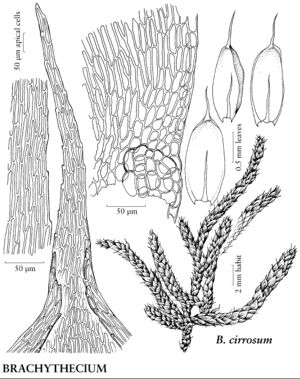Brachytheciaceae
Plants small to large, in loose to dense tufts or mats, light or deep green, yellowish, brownish, stramineous, whitish, or rarely blackish, usually glossy. Stems creeping, ascending, erect, arching, or pendent, green or reddish, densely to loosely terete-foliate, rarely subcomplanate-foliate, irregularly or regularly pinnate, branches usually straight to curved, terete-, subcomplanate-, or complanate-foliate, sympodial branching common; hyalodermis absent, central strand usually present; paraphyllia absent; pseudoparaphyllia acute to acuminate, first leaf pointed downward, second and third situated at 120° from first; rhizoids on stem below leaf insertion or along zone of contact with substrate in creeping stems; axillary hairs of 2–7 cells. Stem leaves appressed, erect, spreading, patent, or falcate-secund, loosely to closely imbricate, rarely well spaced, linear-lanceolate, broadly ovate, or broadly triangular, strongly longitudinally plicate to not plicate; base slightly narrowed or rounded to insertion, short to long and narrowly to broadly decurrent; margins plane to recurved, serrate, serrulate, or entire; apex gradually tapered or acuminate, occasionally piliferous from rounded-cucullate base; costa to (20–)40–100% leaf length, terminal spine present or absent, abaxial surface occasionally toothed; alar cells usually differentiated, larger or smaller than basal laminal cells, region more pellucid or more opaque, usually specific to particular species; laminal cells usually elongate to linear, 6–15:1, occasionally 20:1 or 1.5–5:1, smooth or strongly prorate in distal ends, walls thin to moderately thick, rarely as thick as lumen; basal juxtacostal cells usually shorter, wider than more distal cells, walls usually more incrassate, region more opaque or more pellucid, sometimes undifferentiated. Branch leaves usually smaller, relatively narrower; base more short-decurrent; margins usually more strongly serrate; apex more gradually acute or acuminate; costa usually relatively longer, more often projecting in relatively stronger spine; laminal cells shorter, same width as in stem leaves or rarely narrower; basal cells often not patterned as those of stem leaves, areolation more even across base, cells wider. Specialized asexual reproduction absent. Sexual condition autoicous, dioicous, phyllodioicous, or rarely synoicous; perichaetial leaves in species with horizontal capsules reflexed, base sheathing, apex gradually or abruptly acuminate, costa barely discernible or weak and short, to 1/2 base length, rarely long and vanishing in acumen; perichaetial leaves in species with erect capsules usually straight. Seta red-brown, usually dark red-brown with age, rarely cherry red or orangish, usually long (5–20 times capsule urn length) (short in Zelometeorium), twisted, rough or smooth. Capsule usually horizontal, sometimes erect, color similar to seta; annulus not separating or separating by fragments; operculum conic or rostrate; peristome xerocastique or hygrocastique, perfect (exostome teeth cross striolate proximally; endostome conspicuous, not adherent to exostome (except in Homalotheciella), basal membrane 1/2–1/3 endostome length, segments broad, cilia 2 or 3), sometimes modified (for example, exostome teeth papillose to base, endostome basal membrane less than 1/3 endostome height, cilia reduced or absent, etc.) in association with erect capsules and usually hygrocastique peristome. Calyptra cucullate (mitrate in Zelometeorium), naked, rarely hairy. Spores 9–28 µm.
Distribution
Nearly worldwide. Brachytheciaceae are found throughout Arctic, boreal, and temperate zones, also on high mountains in subtropical and tropical zones, and are more diverse in xeric and Mediterranean climates.
Discussion
Genera 43, species ca. 250 (19 genera, 72 species in the flora).
Brachytheciaceae are found throughout Arctic, boreal, and temperate zones, also on high mountains in subtropical and tropical zones, and are more diverse in xeric and Mediterranean climates.
In most cases, species of Brachytheciaceae are easily recognizable. Distinctive characters include glossy plants, plicate leaves in many species, rough setae in about half of the species (otherwise a rough seta is rare in the North American moss flora), leaves with single costa, relatively short capsules, and the red base of exostome teeth in many species. For poorly distinguishable taxa, the structure of pseudoparaphyllia is diagnostic. In Brachytheciaceae, the first branch leaf is pointed downward and the second and third diverge 120° from it; in most other pleurocarps the first branch leaf is lateral.
M. S. Ignatov and S. Huttunen (2002) divided the family into four subfamilies, all represented in North America: Eurhynchioideae Milde include genera with smooth setae and, with the exception of Pseudoscleropodium, rostrate opercula: Bryoandersonia, Palamocladium, and Rhynchostegium. Helicodontioideae M. Fleischer unite terrestrial Cirriphyllum and Oxyrrhynchium, aquatic Donrichardsia, and epiphytic Clasmatodon, Homalotheciella, and Zelometeorium. All species of this subfamily in North America have rostrate opercula and, with the exception of Clasmatodon, rough setae; epiphytic genera have strongly modified peristomes. Homalothecioideae Ignatov & Huttunen represent a lineage grading toward a xeric environment and include Brachytheciastrum and Homalothecium as the core of the subfamily, but also Eurhynchiastrum; characters of the seta and operculum vary within this group. Brachythecioideae Huttunen & Ignatov are mainly terrestrial mosses in mesic sites, variable in seta characters, but mostly having a conic operculum in the core genera, Brachythecium, Sciuro-hypnum, and Scleropodium, although the basal genera, Bryhnia, Kindbergia, and Myuroclada, have a rostrate operculum.
Selected References
Lower Taxa
Illustrations
Key
| 1 | Stems creeping and pendent flexuose; leaves erect-spreading to squarrose; Florida. | Zelometeorium |
| 1 | Stems creeping, ascending, erect, or arching; leaves appressed, erect, patent, spreading, or rarely squarrose; usually widespread | > 2 |
| 2 | On tree trunks, rarely rock; leaves 0.4-0.7 mm, appressed when dry, spreading when moist; laminal cells 1.5-3:1; exostome teeth 1/2 endostome length. | Clasmatodon |
| 2 | Habitats mainly rock and soil, more rarely tree trunks; some leaves longer than 0.7 mm, rarely all leaves shorter than 0.7 mm, but then not much different dry or moist; laminal cells usually longer than 3:1; exostome teeth longer than or equal to endostome length | > 3 |
| 3 | Branch leaf apices blunt; stem leaf apices gradually tapered or broadly acuminate. | Eurhynchiastrum |
| 3 | Stem and branch leaf apices similar in shape, usually acute or acuminate, rarely obtuse | > 4 |
| 4 | Plants in permanently wet places; stems creeping or arching | > 5 |
| 4 | Plants terrestrial, sometimes subaquatic; stems creeping to erect | > 8 |
| 5 | Costae stout, short-excurrent, percurrent, or to 80-95% leaf length; axillary hairs with cells short, 1.5-2.5:1; s United States. | Donrichardsia |
| 5 | Costae moderate to somewhat stout, to 40-85% leaf length; axillary hairs with cells long, 3-6:1; mainly widespread | > 6 |
| 6 | Leaves strongly concave; margins serrulate to subentire; w North America. | Scleropodium |
| 6 | Leaves flat to slightly or rarely strongly concave; margins usually serrulate to serrate; widespread | > 7 |
| 7 | Alar cells often markedly enlarged, regions conspicuous; sexual condition usually dioicous; operculum conic. | Brachythecium |
| 7 | Alar cells slightly enlarged, regions inconspicuous; sexual condition autoicous; operculum rostrate. | Rhynchostegium |
| 8 | Leaves distinctly plicate (not to moderately plicate in Brachytheciastrum) | > 9 |
| 8 | Leaves slightly or not plicate (concave leaves often form folds that appear as plicae on slides) | > 14 |
| 9 | Alar regions of 10-15 × 5-8 cells; stems irregularly pinnate; leaves erect; margins coarsely serrate; se United States. | Palamocladium |
| 9 | Alar regions of few cells, if many then either stems regularly pinnate or leaves usually appressed; margins serrate, serrulate, subentire, or entire; widespread | > 10 |
| 10 | Stem leaves broadly triangular; bases broadly long-decurrent. | Kindbergia |
| 10 | Stem leaves ovate to lanceolate (occasionally broadly triangular in Brachythecium); bases moderately to slightly decurrent, rarely broadly long-decurrent | > 11 |
| 11 | Basal laminal cells usually somewhat enlarged and wider than more distal cells (except Brachythecium laetum), walls usually moderately incrassate, regions clear across base | > 12 |
| 11 | Basal laminal cells as wide as or slightly wider than more distal cells, walls moderately to strongly incrassate, regions opaque across base | > 13 |
| 12 | Leaves imbricate or falcate-secund; plants small to medium-sized, with orange tinge due to leaves yellow-green and stems reddish; w North America. | Brachytheciastrum |
| 12 | Leaves straight or if falcate-secund then plants medium-sized to large, usually yellow-green to stramineous or at least lacking orange hue, stems not reddish; widespread. | Brachythecium |
| 13 | Basal laminal cell walls moderately incrassate; leaf marginal teeth never recurved; setae usually smooth; widespread in e North America. | Brachythecium |
| 13 | Basal laminal cell walls strongly incrassate; leaf marginal teeth sometimes recurved; setae rough or rarely smooth distally; mostly along Pacific coast (H. sericeum in Newfoundland). | Homalothecium |
| 14 | Stems not julaceous; leaves spreading to erect, at least when moist | > 15 |
| 14 | Stems usually julaceous; leaves ± imbricate when dry or moist | > 28 |
| 15 | Most alar cells enlarged, regions reaching leaf margins, or marginal alar cells hyaline, walls thin | > 16 |
| 15 | Alar cells not enlarged or, if so, then marginal alar cells narrow, rectangular, chlorophyllose, walls of average thickness | > 17 |
| 16 | Leaf margins serrate to serrulate. | Brachythecium |
| 16 | Leaf margins serrate distally to subentire. | Sciuro-hypnum |
| 17 | Plants small, on tree trunks, logs, rock; capsules erect, ovoid or slightly asymmetric; endostome inconspicuous, adherent to exostome; e United States. | Homalotheciella |
| 17 | Plants small to large, on a variety of substrates including soil; capsules inclined to horizontal, rarely erect, usually curved; endostome conspicuous, not adherent to exostome; widespread | > 18 |
| 18 | Leaf length to width ratio more than 3:1 | > 19 |
| 18 | Leaf length to width ratio less than 3:1 | > 20 |
| 19 | Alar cells small, walls moderately thick. | Brachytheciastrum |
| 19 | Alar cells somewhat enlarged, walls thin. | Brachythecium |
| 20 | Costal terminal spine present, costae broad throughout; operculum rostrate | > 21 |
| 20 | Costal terminal spine usually absent, if present, then costae much thinner distally than proximally; operculum usually conic (rostrate in Rhynchostegium) | > 23 |
| 21 | Branch leaf laminal cells strongly prorate; stem leaves ovate. | Bryhnia |
| 21 | Branch leaf laminal cells not or occasionally prorate; stem leaves broadly triangular or ovate to ovate-lanceolate | > 22 |
| 22 | Stem leaves broadly triangular; bases broadly long-decurrent; branch leaves ovate-lanceolate to lanceolate; stems regularly pinnate. | Kindbergia |
| 22 | Stem leaves broadly ovate to ovate-lanceolate; bases narrowly short-decurrent; branch leaves broadly ovate, ovate-lanceolate, or elliptic; stems irregularly or sometimes regularly branched. | Oxyrrhynchium |
| 23 | Sexual condition autoicous or synoicous; setae rough | > 24 |
| 23 | Sexual condition autoicous and setae smooth, or dioicous, sporophytes rare, and setae smooth or rough | > 26 |
| 24 | Plants small; leaves 0.2-0.5 mm wide; sexual condition synoicous. | Brachytheciastrum |
| 24 | Plants medium-sized to large; leaves usually wider than 0.6 mm; sexual condition autoicous | > 25 |
| 25 | Plants large; stem leaves 1.8-3 × 0.8-1.6 mm; apices gradually tapered; leaves moderately plicate; margins serrulate to moderately serrate. | Brachythecium |
| 25 | Plants medium-sized, if large (S. curtum) then stem leaves 1.4-2.4 × 0.9-1.5 mm; apices abruptly tapered; leaves not plicate; margins coarsely serrate. | Sciuro-hypnum |
| 26 | Plants large, pale green; stem leaves patent, 2.2-3.7 × 1.3-2 mm; apices short-acuminate or apiculate; middle elevations of mountains of w North America. | Sciuro-hypnum |
| 26 | Plants small to large, green, yellowish, or brownish; stem leaves erect to patent, if longer than 2.5 mm and wider than 1.5 mm, then apices narrowly acute or long-acuminate; widespread | > 27 |
| 27 | Operculum conic; plants yellowish, brownish, or stramineous; stems terete-foliate; widespread. | Brachythecium |
| 27 | Operculum rostrate; plants light green to whitish; stems terete-to subcomplanate-foliate; e North America. | Rhynchostegium |
| 28 | Leaf apices abruptly tapered, piliferous | > 29 |
| 28 | Leaf apices gradually tapered, not piliferous | > 30 |
| 29 | Plants usually yellow-green, rarely green; stems irregularly pinnate; alar cells small, regions usually opaque. | Brachythecium |
| 29 | Plants light green or whitish; stems regularly pinnate; alar cells enlarged, regions pellucid. | Cirriphyllum |
| 30 | Leaves 0.2-0.8 mm wide | > 31 |
| 30 | Some leaves 0.9-1.4 mm wide | > 36 |
| 31 | Sexual condition autoicous | > 32 |
| 31 | Sexual condition dioicous | > 33 |
| 32 | Plants small; leaves usually 0.2-0.5 mm wide, broadest at 1/5-1/3 leaf length. | Brachytheciastrum |
| 32 | Plants medium-sized; leaves usually 0.6-0.9 mm wide, broadest at 1/10-1/5 leaf length. | Sciuro-hypnum |
| 33 | Leaf apices acuminate | > 34 |
| 33 | Leaf apices acute | > 35 |
| 34 | Plants medium-sized to large; leafy shoots wider than 0.4 mm when dry; stem leaves usually erect or spreading, rarely appressed, if appressed, then plants larger and alar regions smaller, reaching from margin usually less than 50% distance to costa. | Brachythecium |
| 34 | Plants small to medium-sized; leafy shoots 0.3 mm wide when dry; stem leaves appressed when dry; alar cells small, regions extensive, triangular, reaching from margin (50-)100% distance to costa. | Scleropodium |
| 35 | Leaf margins strongly serrate; costal terminal spine present. | Oxyrrhynchium |
| 35 | Leaf margins serrulate to subentire; costal terminal spine indistinct or. | Scleropodium |
| 36 | Most laminal cells shorter than 7:1 | > 37 |
| 36 | Most laminal cells longer than 7:1 | > 39 |
| 37 | Stems mostly unbranched and leaves tightly appressed, resulting in wormlike appearance; Alaska. | Myuroclada |
| 37 | Stems ± branched and leaves moderately appressed, not wormlike; widespread | > 38 |
| 38 | Branch leaf laminal cells prorate. | Bryhnia |
| 38 | Branch leaf laminal cells not prorate. | Sciuro-hypnum |
| 39 | Leaves slightly to strongly concave; apices acute to acuminate, not or weakly apiculate | > 40 |
| 39 | Leaves strongly concave; apices apiculate | > 41 |
| 40 | Alar cells rarely enlarged, not conspicuously larger than adjacent cells, or, if larger or inflated or both, then regions indistinctly delimited. | Brachythecium |
| 40 | Alar cells enlarged, larger than adjacent cells, regions abruptly delimited. | Sciuro-hypnum |
| 41 | Alar cell walls thin; sexual condition autoicous. | Sciuro-hypnum |
| 41 | Alar cell walls thick; sexual condition dioicous | > 42 |
| 42 | Stems regularly to irregularly pinnate. | Pseudoscleropodium |
| 42 | Stems irregularly branched | > 43 |
| 43 | Leaf margins serrate to serrulate; operculum rostrate; e North America. | Bryoandersonia |
| 43 | Leaf margins serrulate to subentire; operculum conic; w North America. | Scleropodium |


